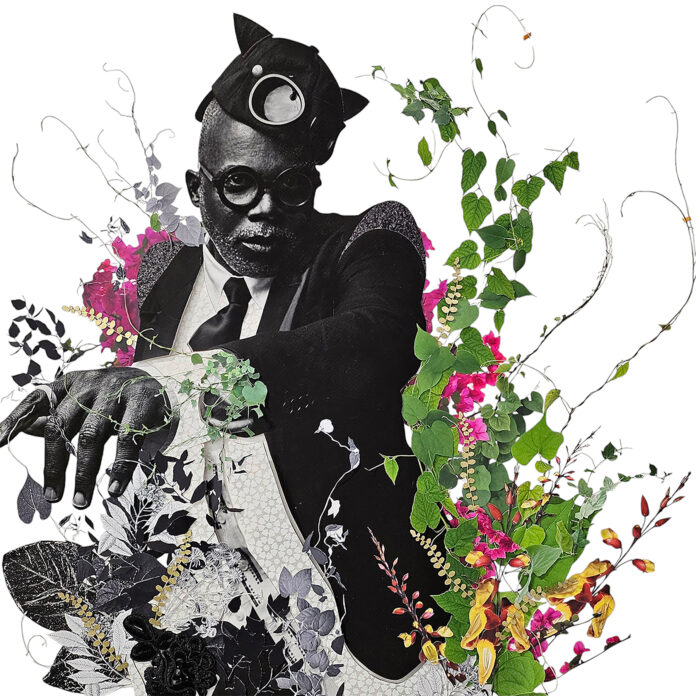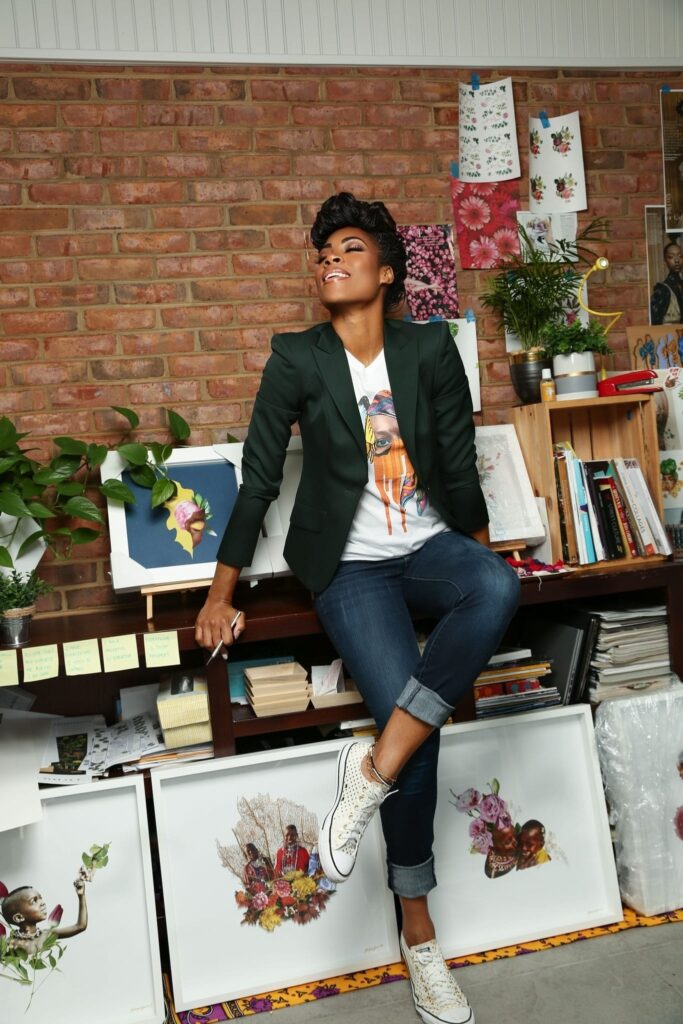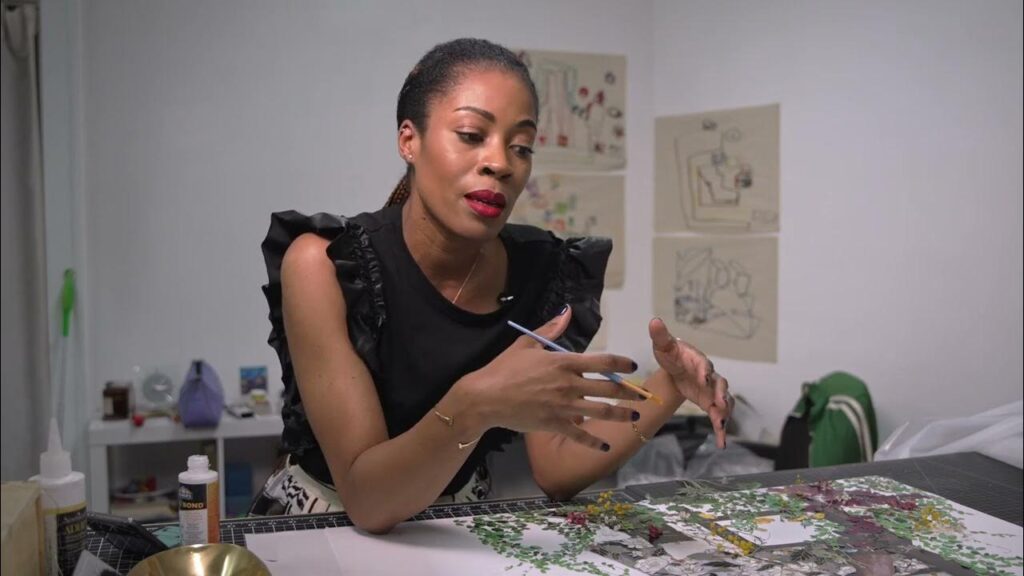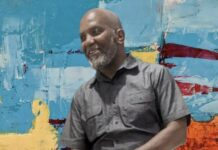
Marryam Moma is a Tanzanian-Nigerian artist whose layered paper collages have redefined how we see, honor, and preserve Black narratives. Trained in architecture at Temple University’s Tyler School of Art, she brings structural clarity and deliberate precision to her practice, fusing analog techniques with bold storytelling that confronts stereotypes and amplifies Black joy. Her work has traveled across multiple platforms from the pages of Popular Science and XXL Magazine to hit television shows like Blackish and Bel-Air, and finding a permanent place in corporate collections of Google, Microsoft, Starbucks, Home Depot, and beyond. Grounded in her cultural heritage and nurtured in the artistic landscape of Atlanta, Moma’s practice extends from intimate studio collages to monumental public works—all united by a commitment to representation, inclusivity, and community empowerment.
How has your training in architecture shaped your creative vision and the way you construct your narratives through art?
Moma: My architectural background influenced my approach to collage, which was guided by structural clarity and spatial relationships. Architecture taught me to investigate how elements interact within given parameters and to eliminate the extraneous until resonance was achieved. This disciplinary foundation enables me to compose narratives with precision, with each cut and layer serving a precise function in the overall composition. My collages are not spontaneous assemblages, but instead well-organized visual arguments that use architectural logic to amplify underrepresented voices and confront simplistic preconceptions about Black bodies with an authoritative aim.
You’ve been featured in such a wide range of platforms. What does it mean for you to see your work in such diverse cultural spaces?
Moma: Seeing my art appear in such a wide range of cultural contexts reaffirms the universality of visual storytelling. Each platform offers a distinct opportunity to challenge assumptions about Black bodies and experiences. When my collages appear on the cover of XXL or in Blackish episodes, they are more than just ornamental components; they are agents of representation, bringing debates about Black joy and strength to mainstream consciousness. This cross-cultural visibility underscores how art can transcend traditional boundaries and foster meaningful dialogue in places where such conversations would not typically occur.
Your project ICONoclasts celebrates revolutionary Black figures through intricate paper cut collages. What was the emotional and intellectual journey of creating this body of work, and what impact do you hope it has on those who experience it?
Moma: Creating ICONoclasts was both emotionally liberating and intellectually challenging. I wanted to focus on the disruptors, the door openers, and the route pavers. Each portrait—from James Baldwin to Stevie Wonder to Tennessee legislators—required lengthy study to fully engage with their personal stories. I absorbed their life stories, accomplishments, and challenges. The process was both relaxing and demanding, as I attempted to capture their essence using paper and mixed media. I hope viewers are inspired to learn more about these figures and feel emboldened to become iconoclasts themselves, taking control of their surroundings and disrupting the status quo in their own communities.
Residencies have been pivotal to your growth. How do you approach these opportunities; what do they allow you to explore that you couldn’t otherwise?
Moma: Residencies give vital space for artistic experimentation and community formation. The Hambidge Center Distinguished Artist Fellowship supplemented my narrative-driven solo exhibitions. At the same time, blended teaching residency opportunities, such as the Swimming Hole Foundation in upstate New York, allowed me to escape economic demands and experiment with new techniques and scales. These experiences allowed me to experiment with three-dimensional work, which ultimately impacted my United Nations sculpture. My studio practice evolved as I experimented with new techniques and sought deeper connections with the artistic community through partnerships and idea exchanges. Residencies are more than just solitude; they are about connecting with other artists, learning from them, and pushing creative boundaries.
Your art is included in collections at major companies. How do you balance the intimacy of creating analog collages with the scale of having your work reach such global platforms?
Moma: There’s a lovely contrast between the intimacy of hand-cutting paper and the vast scope of corporate collections. Each piece begins with my hands in my Atlanta studio, The Glassbox—cutting and layering in a meditative, personal process that I could spend hours on. However, when these private compositions reach worldwide audiences, they retain their original intent: to challenge preconceptions and celebrate the multifaceted Black experience. The scale of reach enhances the message while maintaining the personal touch. Whether someone sees my work at a Google office or a Starbucks, they’ll see the same meticulous paper-cuts, composition, and deliberate color choices that emerge from my quiet studio practice.
In what ways has Atlanta shaped your perspective and your approach to public art and community engagement?
Moma: Atlanta has presented itself as a melting pot of opportunities. There’s a reason it’s known as the Black Mecca. I’ve seen numerous prospects for growth and success here. My public works, which range from my mural at Clark Atlanta University to the planned Quilts in the Sky sculpture for the BeltLine in collaboration with a textile artist and peer, Adana Tillman, are constantly inspired by the city’s rich Black cultural heritage. Atlanta’s history of civil rights leadership, strong modern arts scene, and status as an artistic powerhouse all influence my approach to community engagement. I am deeply humbled by the way I have been accepted and embraced. Atlanta allows me to dream large and create work that honors Black brilliance.
Share with us how you source your materials and what guides your selection process in bringing disparate fragments into cohesive, powerful narratives?
Moma: My material selection is deliberate—I want images that defy preconceptions while praising Black bodies. I collect antique publications and contemporary photography, and I also photograph the images in my work, which occasionally incorporate botanical imagery and architectural elements. Each fragment must contribute to the narrative, such as unique flowers that represent a subject’s birthplace. For example, the Snowball Viburnum foliage in one ICONoclasts piece focused on primarily Atlanta disruptors is featured in a building-wide installation on Auburn Avenue today. It grows naturally in Cleveland, directly in front of the foster home where my subject, Ricci De Forest lived. Deconstructing and reintegrating images becomes an intuitive visual experience, where color, texture, balance, shape, and space generate new associations and meanings.
How do your cultural roots influence the stories you tell through your work?
Moma: My Tanzanian-Nigerian heritage pervades every aspect of my work, from the Ubuntu philosophy that underpins my UN sculpture Melanin Machina, which means “I am because we are,” to celebrating features that were mocked in my childhood in my series inspired by my siblings’ stories of college life in predominantly white spaces. This work arose from recollections of siblings being mocked for their Afrocentric features—full lips, large foreheads, and wide hips—and turned that anguish into celebration. My cultural roots supply both topic matter and philosophical context. The community ideals of African cultures influence how I approach representation—it is never just about individuals but about collective power and resilience. These roots allow me to make work that addresses diasporic experiences while being grounded in ancestral wisdom.
In today’s social climate, what role do you believe visual artists like yourself play in bridging divides and sparking dialogue?
Moma: Visual artists act as cultural translators, making complex social topics accessible through beauty and emotion. My collages spark discussions about identity, agency, and social justice by questioning the status quo. People are drawn to the brilliant colors and rich details, which lead to deeper messages about representation and dignity. In our polarized world, art offers a neutral ground where individuals can encounter viewpoints they might otherwise reject. I mirror the area and space in which I live, conveying core Black life experiences and accentuating Black joy. Art bridges gaps by celebrating shared humanity while acknowledging distinct cultural experiences, thus providing entry points for challenging but necessary discussions about equality and justice.
What does expansion look like for you?
Moma: My responsibility as an artist is to provoke thought and discussion, to document and invite, to educate and liberate. I’m branching out into larger public pieces like the Atlanta Beltline sculpture, as well as three-dimensional installations like Melanin Machina, which I created for the United Nations. Drawing on my modeling experience, I foresee collaborations that combine fashion and creative art. I included children in my UN sculpture because they are part of this history. I have a three-year-old son and want to involve him in whatever I create.
What legacy do you hope your work leaves?
Moma: My legacy should be art that radically changes society’s perception of Black bodies, moving away from destructive stereotypes and toward an authentic celebration of our strength, joy, and entire humanity.









